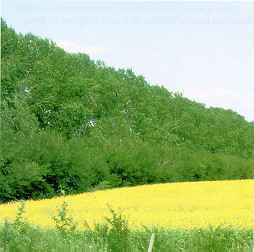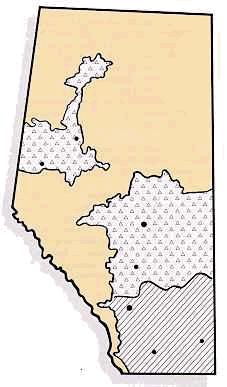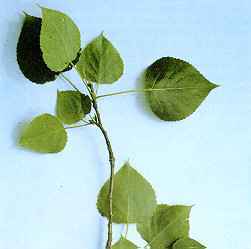| | Plant characteristics | Fall colour | Site preference | Hardiness | Uses | Problems | Diseases | Insects | Pruning
.

Scientific Name: Populus x Jackii Northwest
Plant Characteristics This poplar is considered a natural hybrid between the plains cottonwood and balsam poplar (Populus deltoides x Populus balsamifera). The tree was introduced as a male clone by the Northwest Nursery, Valley City, North Dakota.
It is a tall deciduous, usually single stemmed tree with a round to upright crown. It is fast-growing with a possible mature height of 25 m (80 ft), but usually 15 to 18 m (50 to 60 ft), with a spread of about 15 to 20 m (50 to 65 ft). It can be expected to reach a height of 6 m (20 ft) in five to seven years from a one - year - old rooted cutting. It is fast-growing, but is also short-lived, approximately 15 to 30 years. It is distinguished by strong wide-angled branches with large leaves at the ends. Leaves appear in late spring and drop relatively early.
Bark - Young bark is very smooth, greyish-green in colour, with striped lenticels. Older bark stays smooth and does not have the heavy grooves of the older black poplar and cottonwood.
Buds - Buds are elongated, three times longer than wide, acute, outcurved, gummy, pubescent. There are eyelash-like hairs at the base of the bud. Leaf scar is triangular and large.
Leaves - Leaves are alternate, simple, shiny green, broadly ovate with sinuated edge. Base is flattened or rounded. Blade is nearly as wide as long (to 10 cm or 4 in.); with hairs, midrib sparingly pubescent on both surfaces. Petioles are reddish, cross-section oval, 0 to 2 terminal glands present.
Propagated by cuttings.
Fall Colour
Leaves - golden yellow.
Site Preference
Wide soil adaptation. Requires generous amounts of water, but can survive drought conditions. Can be planted in full sun or half shade.
Hardiness
Alberta. Tolerates early and late frosts.
.


Uses
For farmstead windbreaks, poplars should be planted in combination with a conifer. Leave 5 to 8 m (17 to 26 ft) between the rows and 2 to 4 m (6 to 13 ft) between the trees. In shelterbelt situations it should be planted 2 to 4 m (6 to 13 ft) between trees in the row and 5 to 8 m (17 to 26 ft) between rows.
It is also planted as a shade tree, accent planting, background, street tree, parks planting and in shelterbelts. Too large for a normal city lot, but good for large properties and parks. It is one of the two most desirable large male hybrid poplars in Alberta, the other one being the Brooks poplar.
Problems
Extensive root system may spread up to four times the height of the tree. Roots may invade existing cracks in pavement, concrete and sewer lines, causing further damage. Roots will sucker if damaged.
Diseases
Canker - usually associated with a major setback, e.g. heavy pruning, transplanting, root disturbance, old age, and drought.
Insects
Forest tent caterpillars. Gall mites (in southern Alberta) disfigure the tree and reduce vigour, making it more susceptible to canker.
Pruning
Light spring pruning is preferred to remove dead, diseased or damaged branches. Old wood is somewhat brittle and the tree requires expert maintenance in old age. Usually allowed to develop multistems in shelterbelts.
.

Shelterbelts Varieties for Alberta provides information on a number of other trees and shrubs than may be suitable for shelterbelts.
Visit our website directory for the Reforestation Woodlot Listings. |
|